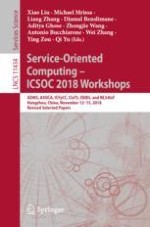This book constitutes the revised selected papers of the scientific satellite events that were held in conjunction with the 16th International Conference on Service-Oriented Computing, ICSOC 2018, held in Hangzhou, China, in November 2018.
The ICSOC 2018 workshop track consisted of six workshops on a wide range of topics that fall into the general area of service computing. A special focus this year was on Internet of Things, Data Analytics, and Smart Services: First International Workshop on Data-Driven Business Services (DDBS)First International Workshop on Networked Learning Systems for Secured IoT Services and Its Applications (NLS4IoT)8th International Workshop on Context-Aware and IoT Services (CIoTS)Third International Workshop on Adaptive Service-oriented and Cloud Applications (ASOCA2018)Third International Workshop on IoT Systems for Context-aware Computing (ISyCC)First International Workshop on AI and Data Mining for Services (ADMS)
